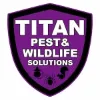Taking proactive steps to identify and address potential issues can create a safer and more enjoyable environment for you and your family.
Stinging insects play essential roles in nature, such as pollination and insect control. However, some of these creatures can pose significant health risks, particularly for individuals with allergies.

Types of Stinging Insects That Cause Allergic Reactions
Here are the most common types of stinging insects that cause allergic reactions. Effective pest control measures can help mitigate the risks.
- Honeybees – Honeybees are vital pollinators and produce honey. For most people, honeybee stings cause mild pain, redness, and swelling at the site of the sting. However, some individuals may experience severe allergic reactions, known as anaphylaxis. Anaphylaxis is a life-threatening condition that requires immediate medical attention.
- Yellow Jackets – Yellow jackets are aggressive wasps known for building nests in the ground or other concealed areas. Their stings are painful and can lead to localized swelling and redness. Stings can trigger severe reactions in allergic individuals, including difficulty breathing, hives, and even anaphylaxis.
- Paper Wasps – Paper wasps construct open, umbrella-like nests under eaves and ledges. They are less aggressive than yellow jackets but can still deliver painful stings. Allergic reactions to paper wasp stings can range from mild to severe.
- Hornets – Hornets are larger wasps that create large nests in trees, bushes, or buildings. Their stings are potent and can cause significant pain, swelling, and redness. For individuals with allergies, hornet stings may trigger anaphylaxis.
If you have reason to believe that you may have a severe allergy to stinging insects, it is essential to seek the advice of a qualified medical professional to discuss appropriate management strategies and emergency protocols.
The Role of Professional Pest Control in Mitigating Risks
Stinging insects can seriously threaten individuals with allergies, making professional pest control a vital aspect of ensuring a safe and comfortable living environment.
- Expert Inspection and Identification: Professional pest control technicians are trained to identify different species of stinging insects and their nesting sites. Their expertise allows them to determine the level of risk posed by an infestation and develop a targeted action plan.
- Safe Removal of Nests: Attempting to remove stinging insect nests without proper knowledge and equipment can be hazardous. Professional pest control services have the experience and tools to remove nests safely and efficiently, reducing the risk of accidental stings.
- Preventive Measures: Pest control experts address existing infestations and implement preventative measures to keep stinging insects at bay. By sealing entry points, applying insecticides in targeted areas, and advising homeowners on potential attractants, pest control professionals create a less inviting environment for stinging insects.
- Customized Solutions: Every property is different, and a one-size-fits-all pest control approach may be ineffective. Professional pest control services tailor their strategies to each unique situation, considering the type of stinging insects present, the property’s layout, and the homeowner’s specific concerns.
- Regular Monitoring: Pest control is not a one-time event; it requires ongoing vigilance. Professional technicians offer regular monitoring and follow-up visits to ensure that the infestation is entirely eradicated and that no new nests have formed.
At Titan Pest & Wildlife, our team has over 35 years of experience as professional exterminators removing pests for our clients. If you’re dealing with a pest infestation, don’t wait for it to go away on its own. Protecting your home from pests can be a challenge. Our licensed and certified exterminators are committed to providing our customers with complete pest control solutions.

